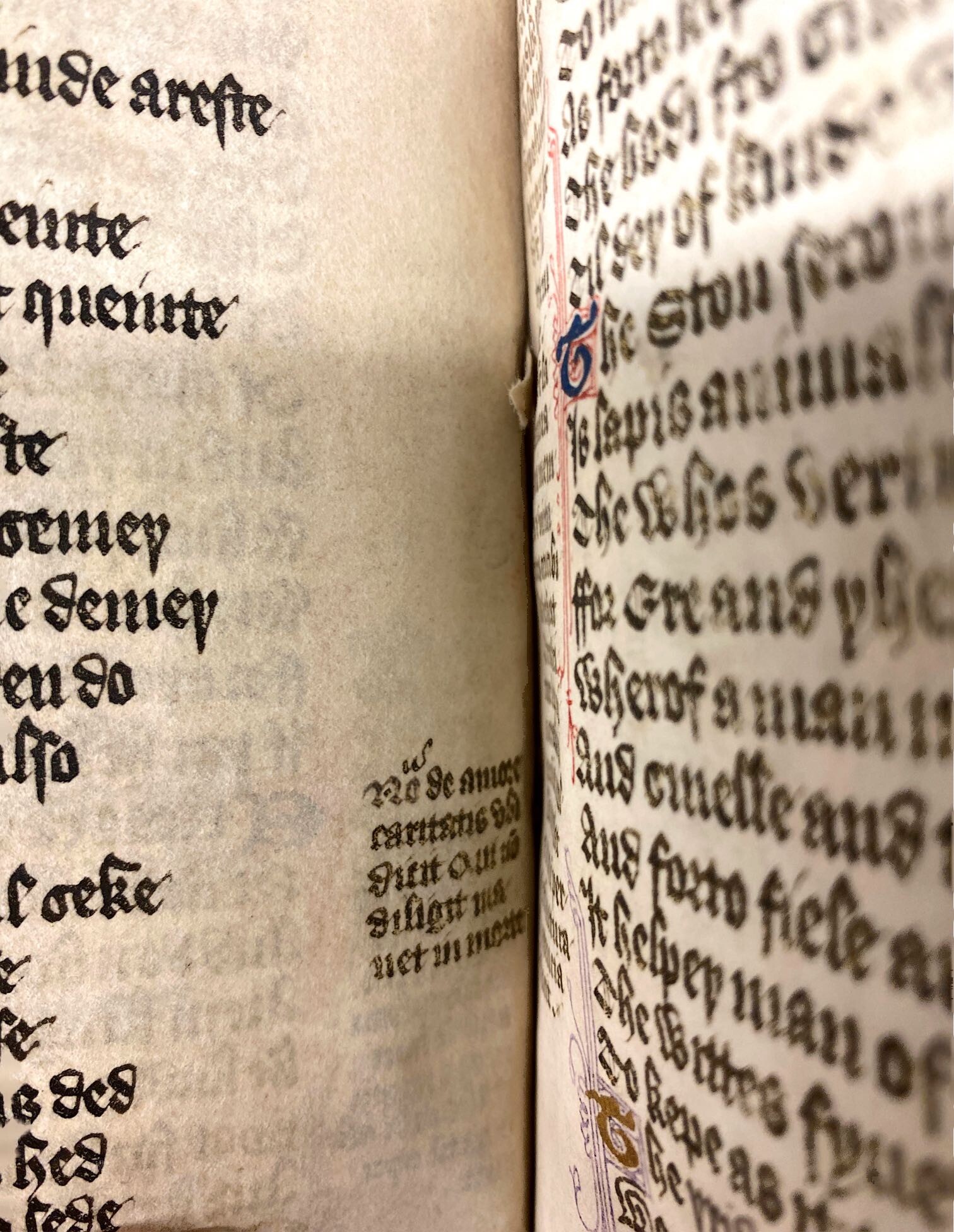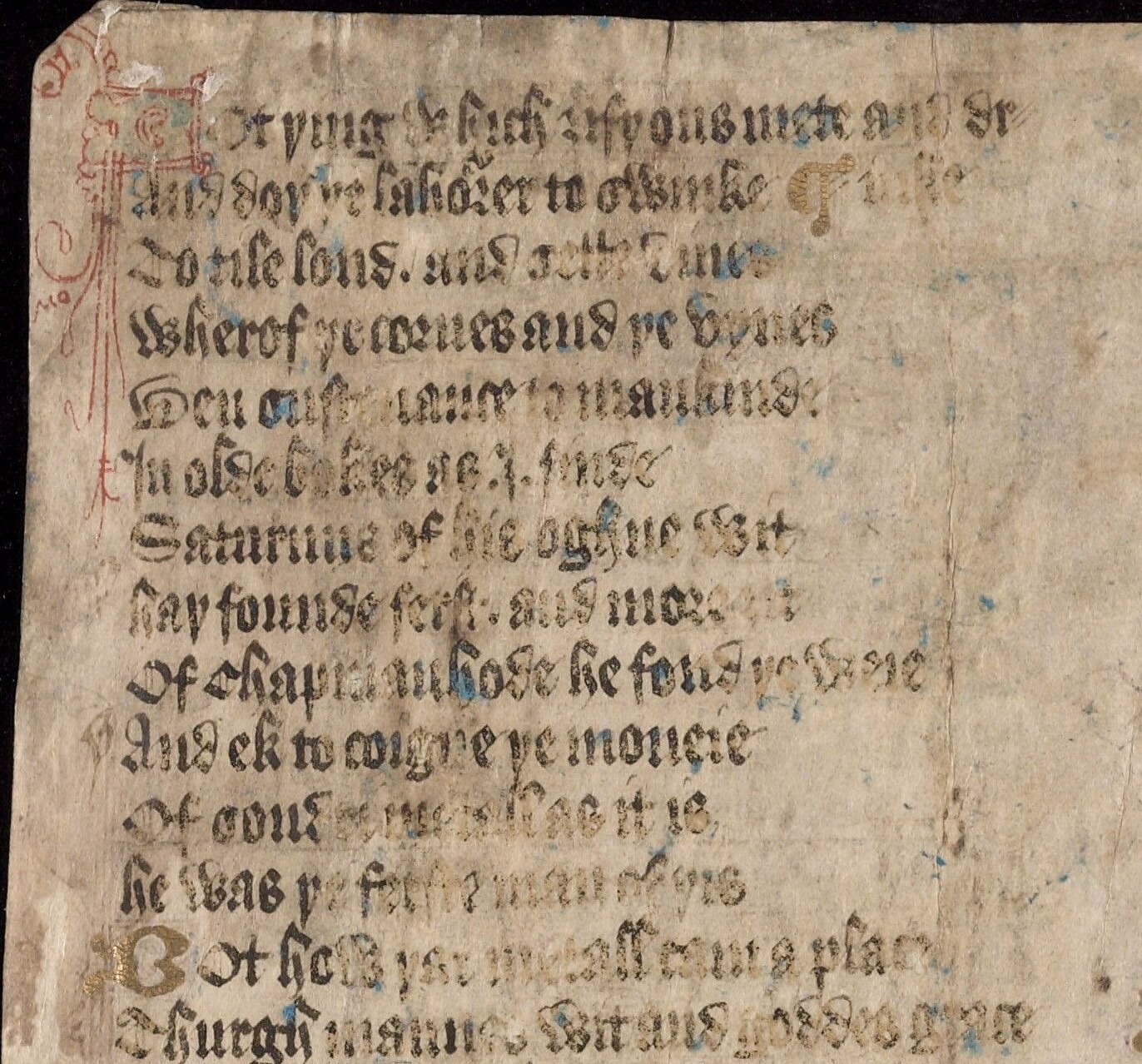Takamiya MS 98: An Excised Fragment of the Stafford Gower
The Stafford Gower (Huntington Library MS EL 26 A 17) is a late-fourteenth century manuscript of John Gower’s Confessio Amantis (“The Lover’s Confession”), a 33,000-line Middle English poem which compiles a number of tales within the frame-narrative of a lover delivering a confession to Genius, the chaplain of Venus. Notwithstanding a one-book digression, each book is devoted to one of the seven deadly sins and the exempla which Genius provides in hearing the Lover’s confessions.
Originally composed for Richard II between 1386 and 1390, the Confessio underwent a number of revisions throughout the political crises of its time. As Henry of Lancaster (soon to be Henry IV) accumulated power in his conflict with the King, Gower composed a second recension of the poem. This new version, issued in 1392, scrubbed any reference to Richard II from the Prologue, rededicated the poem to Henry, and included a number of stylistic changes. One year later, Gower issued a third recension with further modifications.
Between the three versions, the Confessio is one of the most widely-copied manuscripts of Middle English verse. However, the majority of these manuscripts feature the first recension of the text, which makes up thirty-five of the fifty-four complete extant copies of the poem. The Stafford Gower is one of the oldest extant Confessio manuscripts, and is one of the few surviving from before the 1399 deposition of Richard II, along with the authoritative Bodleian Library MS Fairfax 3. Even more significantly, the Stafford Gower is the earliest witness to the second recension of the text and is therefore an important authority for the history of the poem. However, seventeen leaves are missing from various places throughout the book, which renders the Stafford Gower’s significant attestation of the second recension incomplete.

Figure 1. The Stafford Gower, detail of fols 68v–69r. MS EL 26 A 17, The Huntington Library, San Marino, California.
In 1999, one of the missing fragments from the Stafford Gower reemerged in the binding of another book owned by Bernard Quaritch Ltd, a London-based rare book and manuscript dealer. Professor Toshiyuki Takamiya acquired the leaf in 2001, at which point it became Takamiya MS 98, and was later acquired by the Beinecke Library in 2017. Takamiya discovered that the fragment had been excised from its place between folios 68 and 69 of the Stafford Gower and used as binding waste. Such a process was common among medieval binders, who would excise, cut, and crop leaves of parchment so as to line the spines and reinforce the bindings of their books. The Takamiya fragment shows clear signs of such cropping and wear. There are holes through the parchment for sewing cords and sewing lines running across the page where the cords and parchment made contact. Furthermore, the leaf has been cropped from two 48-line columns to incomplete, 36-line columns.
The Takamiya fragment raises a number of questions about the process of excision for the purposes of binding reinforcement. Generally, if a leaf is excised from a manuscript, it is for one of two reasons: either the text contains some profanity which the book’s owner deemed worthy of censorship, or the leaf displays some colorful design which would make for an aesthetic binding. A.S.G. Edwards and Takamiya hypothesize that a number of leaves which had been removed from the Stafford Gower were selected for either of these two reasons. For example, the opening pages of each book in the Stafford Gower includes ornate decorative borders. Those taken from the beginning of Books 5, 7, and 8 may have been selected for their colorful designs. Likewise, many of the other excised leaves concern controversial subject matters, such as the political discussions of the Prologue, or tales about sorcery and incest. However, there is little consistency in the subject matters excised, and, because of its extensive focus on confession and sin, the Confessio is replete with controversial topics that remained uncensored.

Figure 2. Detail of the Stafford Gower, showing the remains of a parchment strip in the gutter between folios 68 and 69 to which Takamiya MS 98 was once attached. MS EL 26 A 17, The Huntington Library, San Marino, California.
In fact, the Takamiya fragment resists any discernable principle of selection. The mise-en-page is simple and uninteresting, containing only blue or gold initials and red or purple pen-flourishes. Such pen-flourishes are common throughout the rest of the manuscript, and do not highlight anything particular about the excised parchment. The fragment’s text consists of a section spanning lines 2351 to 2520 from Book 4, which concerns the sin of sloth. The fragmentary verses discuss the different uses of labor, enumerate famous inventors and discoverers, and introduce an extended discussion of alchemy. Considering these aspects of the fragment, neither aesthetics nor censorship are compelling explanations for the leaf’s removal.

Figure 3. Verso of Takamiya MS 98. Beinecke Rare Book & Manuscript Library.
Even without a clear principle of selection, the excision of Takamiya MS 98 is illuminating for the material culture of its time. The Stafford Gower may hold enough sacrosanctity for the Gower scholars and medievalists of today for its mutilation to seem irreverent, but it is also one of many copies of a widely-copied secular and vernacular poem. The Confessio may have simply been so popular or over-produced that there were plenty of copies to spare. Furthermore, the abundant Confessio manuscripts were soon made obsolete by the early age of printing, during which the text enjoyed a wide and short-lived popularity. William Caxton printed the Confessio in 1483, followed by 1532 and 1554 printings by Thomas Berthelette. Berthelette’s editions include a preface comparing the qualities of Gower and Chaucer as the two laureate English poets, which testifies to Gower’s renown in the sixteenth-century. Following Berthelette’s printings, however, the Confessio was not printed again until 1810, indicating a sharp decline in Gower’s popularity. As poetic tastes shifted, Chaucer remained popular, but Gower became viewed as a moralizing conservative who clung to outdated classical forms. While Confessio editions were abundant, Gower readership waned, so the value of preserving a given Confessio manuscript became next to none.
For the contemporary medievalist, the Stafford Gower is an irreplaceable witness to Ricardian poetry and politics. For the early modern reader, it was an antiquated manuscript of a once-popular, over-produced text. In other words, the Stafford Gower was worth little more than the parchment on which it is written—mere binding waste.
Jared Brunner
March 27, 2022
Selected Bibliography
Clemens, Raymond, and Timothy Graham. Introduction to Manuscript Studies. Cornell University Press, 2008.
Echard, Sián. “Aristocratic Antiquaries: Gower on Gower.” In Printing the Middle Ages, University of Pennsylvania Press, 2008, pp. 97–125.
Edwards, A. S. G., and T. Takamiya. “A New Fragment of Gower’s ‘Confessio Amantis,’” The Modern Language Review 96, No. 4 (2001): 931–936. JSTOR. Link.
Macaulay, G. C. The Complete Works of John Gower, vol. II, Scholarly Press, 1968.
Mooney, Linne R. “DIMEV 4226-9.” Digital Edition of the Index of Middle English Verse. Link.
Pearsall, Derek. “Manuscripts and Illustrations.” A Companion to Gower, edited by Sián Echard, D.S. Brewer, 2004.
Pearsall, Derek and Linne R. Mooney. A Descriptive Catalogue of the English Manuscripts of John Gower’s Confessio Amantis. D.S. Brewer, 2021.
